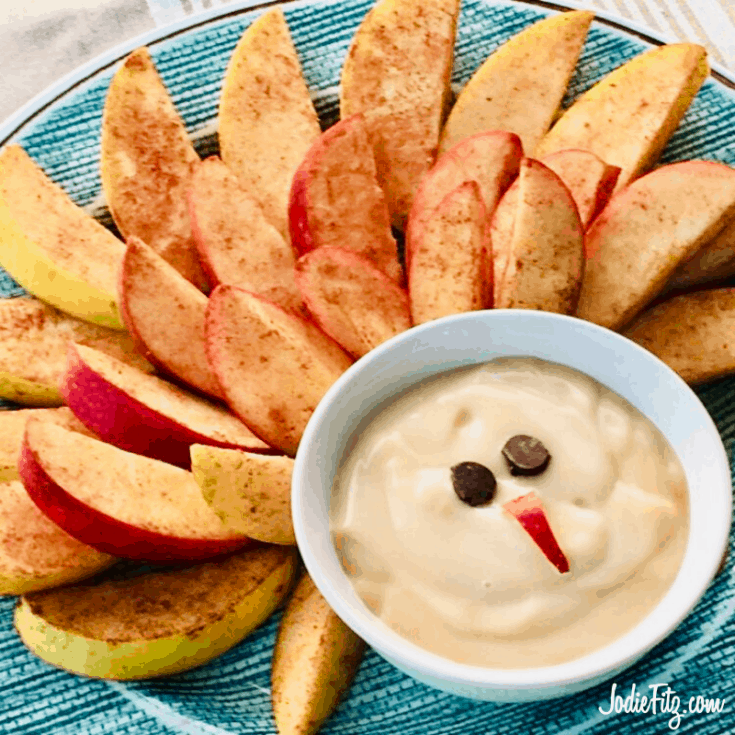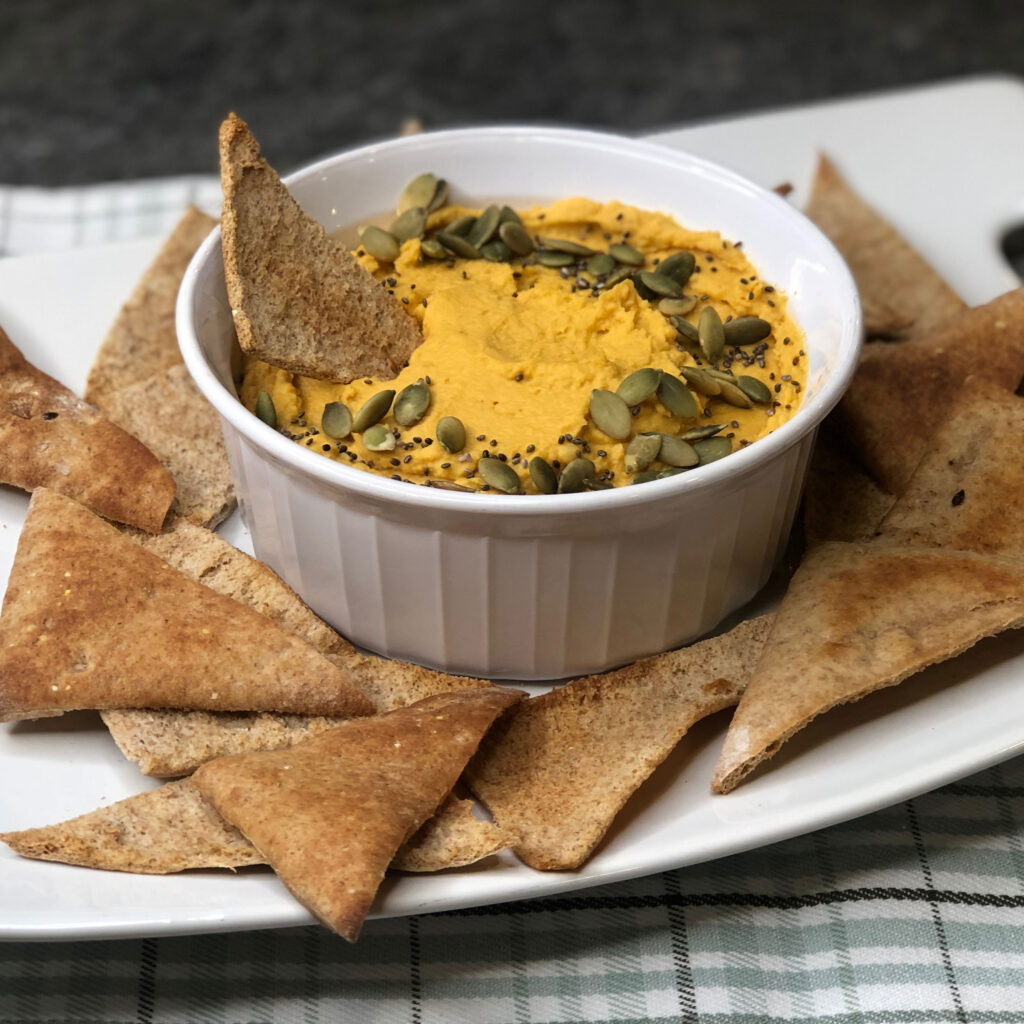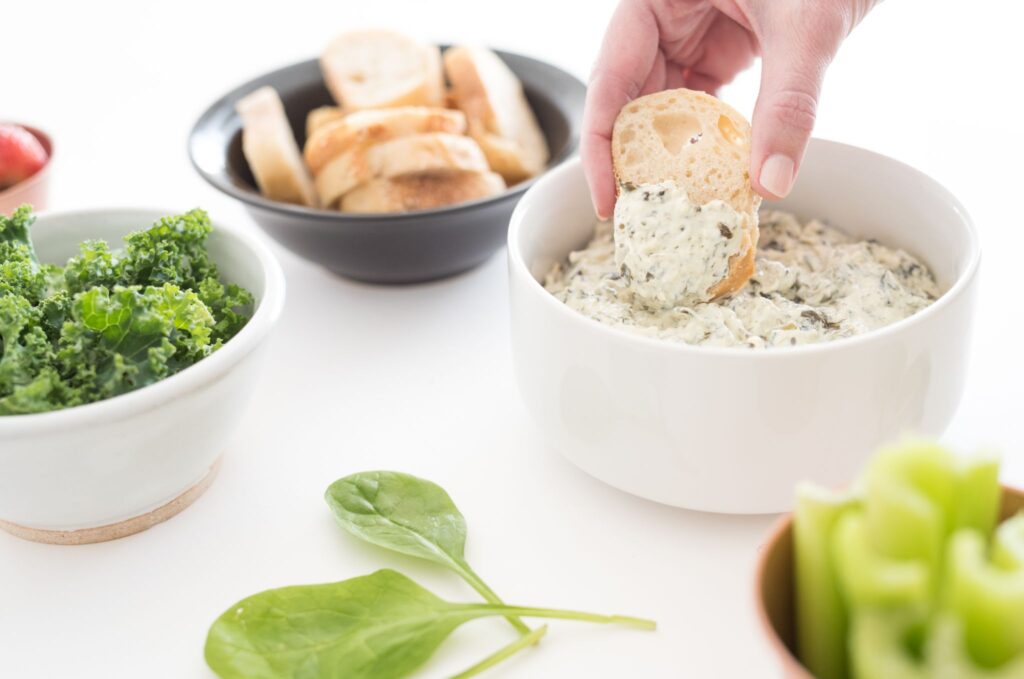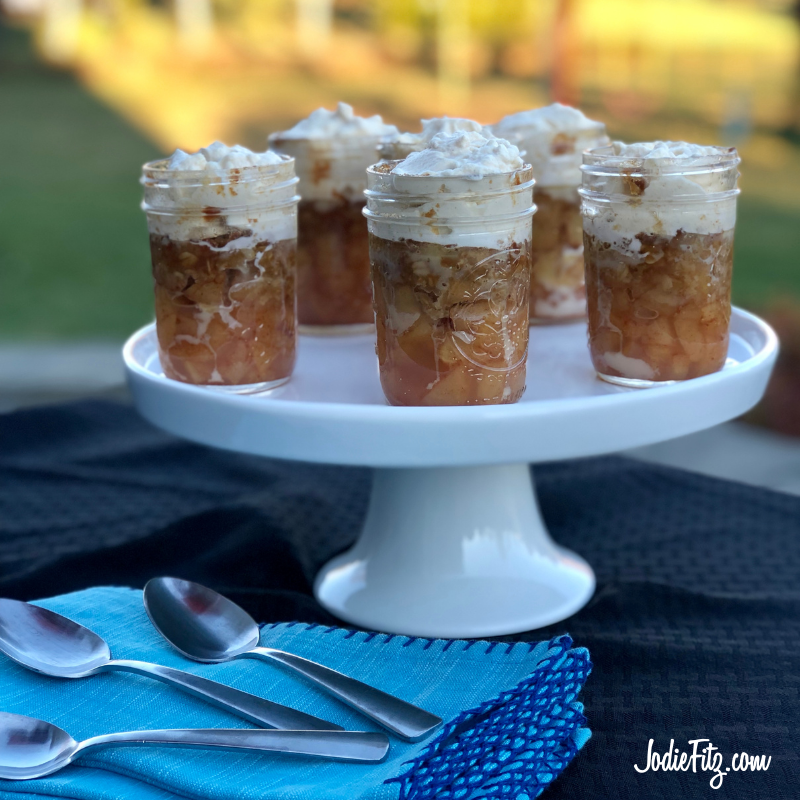
Cinnamon Apples and Dip
by Jodie Fitz
1 Golden Delicious Apple
1 Gala Apple
¾ teaspoon PICS cinnamon
3 oz. PICS Greek vanilla yogurt
2 oz. PICS Vanilla low-fat yogurt
1 tablespoon caramel dip
1 tablespoon peanut butter or WOWButter®
Fold the yogurts together with the caramel dip, peanut butter (or WOWButter®) and ½ teaspoon of cinnamon.
Wash, core & slice the apples. Place the apples in a large snap & seal storage bag. Add in a few shakes of the cinnamon approximately a ¼ teaspoon, seal the bag & shake until the apples are coated with the cinnamon.
Serve the apples with the dip!
Thanksgiving YUM FUN:
For a Thanksgiving twist place the dip into a small bowl. Use either chocolate chips or raisins to serve as eyes on the dip & cut a small piece of apple to serve as a turkey beak. Place the cinnamon covered apples around the dip bowl, on a larger plate to serve as turkey feathers alternating the colors of the apples.
WOWButter® is a peanut free, tree nut free, gluten free peanut butter alternative that can be located in the allergy friendly aisle in your Price Chopper and Market 32 Supermarkets.
Snack, snack, snacking? This recipe is great to pack in the lunchbox or to serve as an afterschool snack. The cinnamon apples help to avoid the brown apple blah.
Storage? You can keep cinnamon apples in a snap and seal storage bag in the refrigerator for several days. And, the dip can be stored in an airtight container in the refrigerator for up to 5 days – 7 days.
Kiddos in the Kitchen: Every recipe has lessons to share with our children. This recipe, even as simple as it is, teaches some of the following concepts:
Cutting and Knife safety
Measuring Ingredients
Folding
Avoiding browned apples
Food storage
Crafting with food


Pumpkin Hummus
by Jodie Fitz
1 can of PICS chickpeas
½ cup PICS pumpkin puree, 100%
1 large clove of garlic
3 tablespoons PICS olive oil
2 tablespoons tahini paste
1 tablespoon lemon juice
½ teaspoon sea salt
¼ teaspoon onion powder
¼ teaspoon garlic powder
1/8 teaspoon cinnamon
1/8 teaspoon coriander
Optional: Pepitas and Chia Seeds
Drain the chickpeas and place them in mini chopper or food processor. Add in the pumpkin puree, olive oil, garlic, tahini paste, lemon juice, sea salt, onion powder, garlic powder, cinnamon and coriander.
Blend the mixture together until the ingredients are mixed well. You most likely will have to pause and scrape the ingredients down one or two times during the mixing process.
Pour the hummus into a bowl.
Optional: Sprinkle around the edge with pepitas and/or chia seeds.
DIPPING? Dip with fresh veggies or pita chips.
How to Make Pitta Chips?
Preheat the oven to 375 degrees. Cut your pita(s) with a pizza cutter into triangle pieces and tear them apart for a single layer. Spray a nonstick baking sheet with a nonstick cooking spray. Place the pita pieces on the tray. Baste them with canola oil. Stir together 1 teaspoon of salt, ½ teaspoon onion powder and a ¼ teaspoon garlic powder. Sprinkle it on top and bake for 5 to 7 minutes.
Storing? Keep your extra hummus in the refrigerator in an airtight container for up to 3 – 5 days. You can store excess pita chips in a snap and seal style bag in the pantry for several days.
Lessons for Kids: Every recipe has lessons to share with our children. This recipe, even as simple as it is, teaches some of the following concepts:
· Measuring ingredients
· Can opening
· Draining
· Safety in using a food processor or mini chopper
· Cutting and blade safety
· Basting
· Sprinkling
· Prepping cookware
· Baking and oven safety
· Dipping
· Food storage


Eat Well with Diabetes
Ellie Wilson, MS, RDN
How can you eat well with diabetes? This is the first question asked when someone is diagnosed, and it comes back up whenever a new fad diet comes along, or a friend reads an article, or new research is shared (or shredded) by the media. There is no single best diet for diabetes, in fact, the research shows that a personalized plan developed by a registered dietitian-nutritionist (RDN) is the most recommended way to get the information needed to enjoy good food and good health while managing diabetes.
The 2019 American Diabetes Association Nutrition Consensus Report, (https://www.diabetes.org/blog/what-can-i-eat) a review of the most recent research that included 600+ studies, is summarized in 6 tips. Here is a snapshot and some ideas for shopping that can get you started.
- Actually, I already gave you the first tip – meeting with a RDN is the best way to get food information that is personalized and puts your lifestyle, taste, favorites and health needs together to get you started or updated on current science and strategies to enjoy eating in a way that will also support good health.
- There are many choices that will fit into your eating plan, including Mediterranean, Vegetarian and more. Understanding how different foods can change blood sugar control is essential to living well with diabetes. The more you know, the more confident you will be that you can make better choices wherever you eat.
- There is no general “prescription” of carbohydrates, protein and fat amounts. Getting that personalized care from a RDN will help you find those targets and hit them.
- There are no “perfect” carbohydrate foods, and no recognized definition of “low carb” eating, but there is some evidence that eating smaller amounts of carbs that also have a good nutrient value supports better blood sugar control. Again, the more you know, the easier making good choices will be.
- A small amount of weight loss can improve how your body handles blood sugar. Just 5% weight loss can roll back the diagnosis of prediabetes, and make diabetes management easier by improving insulin sensitivity.
- Food choices matter – choosing foods with lower sodium and low added sugars is recommended. Swapping out saturated fats for healthy fats, like olive oil and avocado, is also a smart move.
We know this is a challenging diagnosis, and want to help you locate the foods your dietitian and health care team recommend. The Know your colors nutrition guides, including Carb Smart, Heart Smart, and Whole Grain, may be helpful with choosing foods that meet the recommendations of your health care team and food plan. Share the information with your providers, and shop more confidently in our stores. The guides will help you quickly find foods that may fit, and then you can check the label to be sure it meets your needs. Got a nutrition question? Ask me here, https://cms-uat-pch.unataops.com/health-wellness/ and I will email you back!

New Items: La Terra Fina
Since 1983, La Terra Fina has been using quality ingredients to make food you’ll want to share. Because if they’ve learned anything in the kitchen, it’s that good food is at the center of every great get-together. When you’re surrounded by good friends sharing stories, laughs, memories, and of course, good food, you’ve got the recipe for a great time.
La Terra Fina delivers delicious, craveable, versatile, generous amount of premium ingredients. La Terra Fina dips have a natural/clean label i.e. no artificial flavors, colors, preservatives, no trans fats, source non-genetically engineered ingredients, milk and cheeses sourced from cows not treated w/rBST, and are made with only real quality ingredients you can recognize.
La Terra Fina has 4 delicious dips available at Price Chopper:
Spinach Artichoke & Parmesan Dip & Spread: Creamy Parmesan cheese mixed with antioxidant rich spinach and chunks of artichoke in this classic favorite. La Terra Fina Spinach Artichoke & Parmesan Dip is delicious served warm or cold with your favorite vegetables, chips, crackers, or bread. Try it as a spread on a turkey or roasted chicken sandwich or top baked potatoes as a flavorful addition.
Tzatziki: Cucumbers mixed with Greek yogurt to create a rich and delicious Tzatziki Dip In true La Terra Fina style, our Tzatziki has a light, fresh favor and rich thickness that allows for dipping, spreading, and drizzling. Our Tzatziki dip is perfect for anyone exploring Mediterranean food or for those who want to add something special to their sandwiches and veggies. Our Tzatziki is also great for snacking, adding to recipes, and entertaining.
Mexicali: Mexicali is a Midwest / East flavor, close to a taco dip; it has a creamy texture with limited spice. Loosely based on adding a premixed taco seasoning with sour cream for taco night topping. Our dup eliminates the need for cheese, sour cream, and seasoning. Jalapeños provide a little heat, but the real ‘spice’ comes from cumin, oregano, and onions. This dip is a fantastic topping to any Mexican style food or Tex-Mex dish.
Cheesy Artichoke Dip & Spread: We’ve blended three cheeses with tender chunks of artichokes for this savory dip, and we didn’t stop there! Everyone will love the light addition of garlic for some real savory goodness. This dip is perfect fr spreading on sandwiches and wraps. Rich delicious flavor to make everyday special.
Find all flavors in your local Price Chopper deli department!
Try these recipes:

Honey Apple Crisp
by Jodie Fitz
5 apples, large
3 tablespoons water
3 tablespoons PICS honey
1 teaspoon PICS cinnamon
¾ cup PICS brown sugar, light or dark
1/3 cup PICS butter, room temperature
½ cup PICS flour, all purpose
½ cup PICS rolled oats, old fashioned
Pre-heat the oven to 375 degrees.
Wash, peel, core and dice the apples. Place them into a bowl.
Mix the water, honey & cinnamon together and stir it into the diced apples gently until the apples are fully coated.
Fill six 8 oz. glass mason jars three-quarters full with the mixture, packing it down.
In a separate bowl, mix the brown sugar, oats & flour together in a bowl with a fork. Using a pastry cutter (or a fork & knife) cut the butter into the mixture. It will be done when it’s all mixed well and the butter has broken into small cut, coated pieces.
Evenly distribute the topping to the individual jars heaping it over the top just a little.
Bake the jars on a baking sheet for approximately 25 to 30 minutes; until the topping is golden brown & the fruit mixture is bubbling.
Serve warm with Honey Cream.
Prep Ahead: This recipe can be made ahead. You can add the covers and keep them in the refrigerator for several days in advance. Remove the covers and bake the day you plan to serve. Let the jars set out of the refrigerator for 30 minutes before placing them in the hot oven.
Extras? Simply put the covers on the mason jars and keep the extra crisps in the refrigerator for up to five days.
Little Chefs! You can peel and slice the apples, let little chefs dice the apples with a plastic knife.
Kids in the Kitchen: Every recipe has lessons to share with our children. This recipe, even as simple as it is, teaches some of the following concepts:
- Peeling & coring apples
- Slicing and dicing
- Knife safety
- Measuring Ingredients
- Stirring
- Baking and oven safety
- Food storage


More than 54 million people may face food insecurity because of coronavirus. Round up your change to support the fight against hunger.
According to the website of Feeding America, a United States-based nonprofit network of over 200 food banks that feed more than 46 million people:
Millions of children and families living in America face hunger and food insecurity every day.
- Due to the effects of the coronavirus pandemic, more than 54 million people may experience food insecurity in 2020, including a potential 18 million children.
- According to the USDA’s latest Household Food Insecurity in the United States report, more than 35 million people in the United States struggled with hunger in 2019.
- In 2018, 14.3 million American households were food insecure with limited or uncertain access to enough food.
- Households with children are more likely to experience food insecurity. Before the coronavirus pandemic, more than 10 million children live in food-insecure households.
- Every community in the country is home to families who struggle with food insecurity including rural and suburban communities.
- Many households that experience food insecurity do not qualify for federal nutrition programs and need to rely on their local food banks and other hunger relief organizations for support.
Hunger in America, Feeding America, www.feedingamerica.org/hunger-in-america.
To see what else is happening In Our Community visit:

New Items: Montchevre Goat Cheese
With a history dating back to 1989, Montchevre® goat cheese was first produced in a small, 4,000-foot former Cheddar plant in Preston, Wisconsin. Now, more than thirty years later, Montchevre® is the leading brand of goat cheese in the United States.
Since its conception, the brand’s portfolio has expanded and diversified greatly – from its wide selection of plain and trending flavored fresh logs to its aged and specialty goat cheddar and feta varieties, there is something for everyone who’s willing to give goat cheese a try. Remaining true to its original core principles, the Montchevre brand places emphasis on high-quality, wholesome products and outstanding goat cheese production at the very best value. Our fresh milk supply is the driving force behind our brand and is one of the many characteristics that differentiate us from other goat cheeses manufactured in North America.
This year, Montchevre is aiming to inspire consumers to think about goat cheese in new and exciting ways beyond the cheeseboard. Whether it be at breakfast as a topping on pancakes to make them a little more savory, atop guacamole or mixed into your favorite dip recipe to give the original a little twistor incorporated into a new dessert for an extra sweet and tangy bite, the possibilities and flavor potential is endless.


New Items: Eight O'clock Coffee
Do you love the rich and wonderful array of varieties served at your favorite coffee house? Here’s an idea — be your own barista. EOC Barista Blends make your house the coffee house. Just fire up your coffee maker and taste the goodness! Go ahead, write your name on the side of the cup, too.
Black & Tan
This recipe is top secret. What we can reveal is our Black and Tan recipe now has a special spin on it. The result: yin meets yang in a complex, yet perfectly balanced taste unlike any other. So much so, that you may want to keep this subtly spiced, bittersweet chocolatey blend as your secret indulgence. We hope not, because we’d like zillions of folks to enjoy this.
Red Eye Roast
A traditional recipe served in specialty coffee shops, our Red Eye Roast combines 100% Arabica drip coffee with a booster shot of espresso. This bold blend of Ethiopian and Brazilian beans is roasted to perfection for that deep, smoky espresso experience. Who needs a barista?
Mocha Macchiato
Inside this bag is lovingly selected Arabica coffee that artfully blends our medium-bodied espresso roast with nuances of rich, white chocolate. Savor the intense flavor of this chocolatey, creamy, caramel treat at your place, not the coffee place.
K-Cup
Enjoy the delicious flavors of Caffé Americano, Black and Tan and Mocha Macchiato in a quick, convenient size—compatible with all Keurig coffee makers.
Here are a few ways to elevate your coffee experience:
Chocolatey Spiced Caffé Bombon:
Pour 1 cup of EOC Barista Blends Black and Tan coffee over 1/3 cup of sweetened condensed milk and top with steamed milk foam. Sprinkle cinnamon on top for an extra kick.
Honey Bee Latte:
Mix 6 oz. EOC Barista Blends Red Eye Roast coffee with 1.5 tsp. vanilla syrup and 1.5 tsp. honey until combined. Top with steamed milk and enjoy!

Injection Perfection: Insulin 101
Emma Keating
Pharmacy Intern
Insulin is the hormone that your pancreas makes in order to help your body use the glucose (sugar) you ingest for energy. Without insulin, your body’s blood sugar levels can get too high and can lead to long term complications over time. In diabetic patients, insulin injections may be prescribed by your doctor as a part of an individualized treatment plan. While it sounds simple enough there are a lot of things come with insulin injections, so welcome to Insulin 101!
Self-Monitoring 1,2
When taking insulin, it is very important to check your blood sugar regularly as directed by your doctor. While having high blood sugar the problem we are trying to treat, injecting too much insulin can make your blood sugar too low. Low blood sugar, or hypoglycemia, can actually cause its own set of issues indicated by shaking, anxiety/confusion, sweating and chills, along with feeling dizzy. Usually, you will check your blood sugar before your first meal of the day. This is called a “fasting blood sugar” and the average goal is <100 mg/dL but can vary. Your blood sugar goal and the number of times you need to check it may change, so it’s very important to talk to your healthcare provider regularly!
Types of Insulin 3
There are several types of insulin based on how long it will work in your body or how quick it starts to work in your body. When you are first starting, it may take some time along with trial and error to find the dose that works for you.
- Ultra-Rapid Acting – begins to work within 12-20 minutes and lasts 1-3 hours4
- Insulin lispro-aabc (Lyumjev)
- Rapid Acting – begins to work 15-30 minutes after injection and lasts 2-4 hours
- Insulin lispro (Admelog, Humalog)
- Insulin aspart (Fiasp, Novolog)
- Insulin glulisine (Apidra)
- Short Acting – begins to work 30 minutes after injection and lasts 3-6 hours
- Regular insulin (Humulin R, Novolin R)
- Intermediate Acting – begins to work 2-4 hours after injection and lasts 12-18 hours
- Insulin NPH (Humulin N)
- Long Acting – takes several hours to start working, but lasts about 24 hours
- Insulin glargine (Basaglar, Lantus, Semglee)
- Insulin detemir (Levemir)
- Insulin degludec (Tresiba)
- Very Long Acting – starts working in 6 hours, lasts about 36 hours
- Insulin glargine, 300u/mL (Toujeo)
Injection Technique 1,2
Needle and Syringe – Using a needle and syringe means that you will have to draw up insulin from the vial. It is important to know your dose and how much you need prior to drawing up the medication. Afterwards, the insulin is injected under the skin (subcutaneously).
- Wash your hands prior to injecting medication.
- Choose the site to inject: back of the arms, the belly (except for 2 inches around the navel), front and outer side of the thighs, upper hip and upper outer area of the buttocks. Clean the area with an alcohol wipe.
- Pinch up a fold of the skin and quickly inject at a 90 degree angle (unless otherwise directed). Continue to pinch the skin and push the plunger down to inject the insulin. Do not inject medication through clothing.
- Hold in place for 5-10 seconds.
- Release the skin fold and remove the needle from the skin. If you can see insulin (clear fluid) or blood leaking from the injection site then press on the area for several seconds.
Pen Injectors – generally, insulin pens are easier to use as well as easier to bring places if you are on the go! The pen has a container that stores the insulin within it and a dial to preset the exact amount of insulin that you need. You will have to attach a new needle each time and it is very important to never share a pen or needle. The injection is given subcutaneously, using a similar technique to a regular syringe and needle. Instead of pushing down the plunger of the syringe, all you will have to do is push the button on the pen injector. Instructions for use can vary depending on the type of pen, so it is important to talk to your doctor, nurse or pharmacist about proper technique!
Storage 3
Keep your insulin in the fridge until you open it. Unopened vials and pens are good until the expiration date on the device. Once you open a vial or use a pen, keep them at room temperature in a safe, dry place. Avoid extreme temperatures – never store your insulin in the freezer, direct sunlight or in the car. Opened vials expire 1 month after they are opened. Usually pens expire 1 month after they are used, but this date can vary based on the type of device you have so be sure to read the label!
Tips & Tricks 1,2,3
Keep a notebook with all of your medicines and doses, including over the counter items, vitamins and supplements. Also keep track of your blood sugar readings and the amount of insulin you are injecting each day.
Having all of your medications sent to one pharmacy helps cut down on the risk for drug interactions or duplicate medications. This makes it easier for your pharmacist to ensure your medication safety!
It is very important to follow your insulin regimen as directed by your doctor and to not miss any insulin doses. Follow up with your healthcare provider if you have any questions or concerns regarding your treatment plan. Remember, be disciplined with your insulin!
SOURCES
- Weinstock RS, Nathan DM, Mulder JE. Patient Education: Type 1 Diabetes: Insulin Treatment Beyond the Basics [Internet]. 2020 [cited 2020 Aug 27]. Available from: https://www.uptodate.com/contents/type-1-diabetes-insulin-treatment-beyond-the-basics/print
- Wexler DJ, Nathan DM, Mulder JE. Patient Education: Type 2 Diabetes: Insulin Treatment Beyond the Basics [Internet]. 2020 [cited 2020 Aug 27]. Available from: https://www.uptodate.com/contents/type-2-diabetes-insulin-treatment-beyond-the-basics
- Medication Management: Insulin Basics [Internet]. 2020 [cited 2020 Aug 27]. Available from: https://www.diabetes.org/diabetes/medication-management/insulin-other-injectables/insulin-basics
- Introducing Lyumjev [Internet]. 2020 [cited 2020 Sept 1]. Available from: https://www.lyumjev.com/hcp/formulation

So I Have Diabetes... What Now?
Emma Keating
Pharmacy Intern
1.5 million Americans are newly diagnosed with diabetes every year.1 Diabetes is a disorder that disrupts the way your body processes and uses sugar. Insulin is the most important part of regulating your body’s blood sugar – when you intake sugar (or glucose), the pancreas releases insulin in order to move sugar out of the blood and use it for energy in the cells. There are two types of diabetes: type 1 and type 2. In Type 1, the body doesn’t make enough insulin by itself. In Type 2, the body makes insulin but doesn’t react to it the way it should. Either way, a new diagnosis of diabetes can be difficult and intimidating and you may be asking yourself “What now?”
While there is no cure for diabetes, there are several ways that you can control your condition:
Balanced Meals 2,5
While changing your eating habits may be daunting, nutrition is a powerful tool in the management of diabetes. The same nutritional action plan won’t work for everyone – but there are a few general rules that you can start with. Low carb, vegetarian and Mediterranean meal plans have been shown to lower blood pressure, encourage weight loss and lower A1C (a test that measures your average blood sugar). Choose whole and unprocessed foods over processed foods and limit foods with added sugars or refined grain. Eat fresh, frozen or canned non starchy vegetables such as corn, beans, beets, brussels sprouts, broccoli, cauliflower, mushrooms, kale, salad greens, peppers, and tomatoes. Stay hydrated and try drink water instead of sugary drinks such as soda. Know that just because you are changing your eating habits does not mean you won’t have any choices! There isn’t a “magic” regimen that will work for everyone, so find what works best for you to help manage your blood sugar levels.
Active Lifestyle 3,5
Exercising and being active can actually make your body’s cells more responsive to insulin. Making an exercise plan can be frustrating, but the most difficult part about getting into an exercise routine is starting! It does not matter what your baseline is – as long as you start, you are miles ahead of where you were. Start slowly with lighter activities such as walking and set goals for yourself to build along the way.
Staying motivated to keep moving can also be a challenge, but having a long lasting healthy habit is the best way to gain back some control over your diabetes. Having a friend or group to exercise with can be a huge inspiration – they keep you accountable and vice versa. Don’t be afraid to add some variety into your exercise routine, this can help you work more muscles and add a change of pace.
Medications 4,5
There are many types of medication available to help you manage your diabetes! Like changing your diet, there isn’t a “magic” medication regimen that will work for everyone – diabetes treatment is individualized and sometimes it takes a few trials to find what works best for you. Generally, your medication depends on what type of diabetes you have. Some treatment plans include oral medications while others are injectable. For type 2 diabetes, many doctors start by initially prescribing a medication called metformin and then reassessing your blood sugar levels after 2-3 months to see if you would benefit from a higher dose or another medication. For type 1 diabetes, treatment typically starts with insulin right away instead of other types of oral or injectable medication. Self monitoring of your blood sugar may be suggested by your doctor. Be sure to work closely with your doctor and your pharmacist to make sure you are getting the most from your medications!
Some of the medications that your doctor might prescribe may include:
- Metformin – this medication is generally the first treatment option and is prescribed to most people who are newly diagnosed with type 2 diabetes to reduce high blood sugar levels. This is an oral medication that makes your body more responsive to insulin and can be taken once or twice daily.
- Common side effects can include nausea, diarrhea and gas but this can be reduced by taking metformin with food.
- People with serious kidney, liver or heart disease or those that have high alcohol intake should not take metformin.
- Sulfonylureas (glipizide, glyburide, glimepiride) – these medications are some of the first that were developed to treat diabetes! They are the most inexpensive medication for diabetes. They increase the amount of insulin your body makes and work really well at first, but the effects gradually fade.
- These medications can cause low blood sugar or “hypoglycemia” which can present as sweating, shaking, or feeling anxious / confused. If this occurs, quickly eat 10-15 grams of glucose (can be a glucose tablet, or something you have on hand such as fruit juice)
- People with kidney failure should not take these medications.
- DPP-4 Inhibitors (Januvia, Tradjenta, Nesina, Onglyza) – these medications increase the insulin release from the pancreas after a meal. They will help lower A1c, but tend to lower it less than other medications. Usually these medications are taken orally once daily.
- Common side effects can vary depending on the medication, but can include headache and low blood sugar, especially if you are taking it in combination with another medication.
- SGLT2 inhibitors (Invokana, Jardiance and Farxiga) – these medications lower your blood sugar by increasing the amount of sugar your body excretes in the urine. They are typically taken orally once a day. Jardiance and Invokana have been shown to have some benefit in patients with heart or kidney disease.
- Common side effects include urinary tract infections and dehydration.
- GLP-1 Receptor Agonists (Byettam Bydureon, Victoza, Trulicity, Ozempic) – these are injectable medications that increase insulin release after a meal and have a lower risk for low blood sugar. The dosing schedule varies depending on the medication, some are injected weekly while others are daily. They can also assist with weight loss as they tend to make people have the sense of feeling full after eating less.
- Common side effects include nausea, vomiting and diarrhea but tend to improve over time
- Insulin (Novolog, Humalog, Lantus, Basaglar, etc…) – injectable insulin can be added to oral medications or used by itself. When using insulin, it is very important to self-monitor your blood sugar to make sure you don’t inject more than what your body needs as this could cause low blood sugar. Insulin may need to be injected several times daily depending on your blood sugar the type of insulin your doctor prescribes.
Living with diabetes can be very stressful but by keeping up with your medications and developing healthy eating and exercising habits it can be managed. If you have questions or concerns about your treatment plan, don’t be afraid to reach out to your healthcare provider or your local pharmacist at Price Chopper/Market 32!
SOURCES
- American Diabetes Association: Newly Diagnosed [Internet]. 2020 [cited 2020 Aug 27]. Available from: https://www.diabetes.org/diabetes/newly-diagnosed
- American Diabetes Association: Nutrition [Internet]. 2020 [cited 2020 Aug 27]. Available from: https://www.diabetes.org/nutrition
- American Diabetes Association: Get Fit and Stay Fit [Internet]. 2020 [cited 2020 Aug 27]. Available from: https://www.diabetes.org/fitness/get-and-stay-fit
- Wexler DJ, Nathan DM, Mulder JE. Patient Education: Type 2 Diabetes: Overview Beyond the Basics [Internet]. 2020 [cited 2020 Aug 27]. Available from: https://www.uptodate.com/contents/type-2-diabetes-overview-beyond-the-basics?topicRef=1737&source=see_link
- Wexler DJ, Nathan DM, Mulder JE. Patient Education: Type 2 Diabetes: Treatment Beyond the Basics [Internet]. 2020 [cited 2020 Aug 27]. Available from: https://www.uptodate.com/contents/type-2-diabetes-treatment-beyond-the-basics



